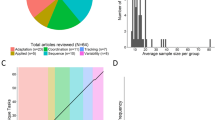Abstract
Motor learning is an expanding field and one in which theoretical perspectives are changing. This review will, therefore, be selective, making only passing reference to some of the classical topics such as feedback and transfer but focusing on what seem to me to be some of the important issues of the moment.
Access this chapter
Tax calculation will be finalised at checkout
Purchases are for personal use only
Preview
Unable to display preview. Download preview PDF.
Similar content being viewed by others
References
Adams, J. A. (1981). Do cognitive factors in motor performance become non-functional with practice? Journal of Motor Behaviour, 13, 262–273.
Allport, D. A. (1980). Attention and performance. In G. Claxton (Ed.) Cognitive psychology: New directions.London: Routledge and Kegan Paul.
Allport, D. A., Antonis, B., and Reynolds, P. (1972). On the division of attention: a disproof of the single channel hypothesis. Quarterly Journal of Experimental Psychology, 24, 225–235.
Annett, J. (1983). Motor learning: a cognitive psychological viewpoint. In H. Rieder, K. Bos, H. Mechling, and K. Reischle (eds.) Motor learning and movement behavior. A contribution to learning in sport. Schorndorf: Verlag Karl Hofmann.
Bryan, W. L., and Harter, N. (1899). Studies on the telegraphic language. The acquisition of a hierarchy of habits. Psychological Review, 6, 345–375.
Corbin, C. B. (1972). Mental practice. In W. D. Morgan (Ed.) Ergogenic aid and muscular performance. New York: Academic.
Crossman, E. R. F. W. (1959). A theory of the acquisition of speed-skill. Ergonomics, 2, 153–166.
Finke, R. A. (1979). The functional equivalence of mental images and errors of movement. Cognitive Psychology, 11, 235–264.
Fitts, P. M. (1964). Perceptual motor skill learning. In A. W. Melton (Ed.) Categories of human learning. New York: Academic.
Gallwey, W. T. (1975). The inner game of tennis. London: Cape.
Grudin, J. T. (1983). Error patterns in skilled and novice transcription typing. In W. E. Cooper (Ed.) Cognitive aspects of skilled typewriting. New York: Springer.
Hirst, W., Spelke, E. S., Reaves, C. C., Canarack, G., and Neisser, U. (1980). Dividing attention without alteration or automaticity. Journal of Experimental Psychology: General, 109, 98–117.
James, W. (1890). The principles of psychology. New York: Holt.
Johnson, P. (1982). The functional equivalence of imagery and movement. Quarterly Journal of Experimental Psychology, 34 A, 349–365.
Kinsbourae, M. (1981). Single channel theory. In D. Holding (Ed.) Human skills. Chichester: Wiley.
Long, J., Nimmo-Smith, I., and Whitefield, A. (1983). Skilled typing: a characterisation based on the distribution of times between responses. In W. E. Cooper (Ed.) Cognitive aspects of skilled typewriting. New York: Springer.
Mackay, D. G. (1981). The problem of rehearsal or mental practice. Journal of Motor Behaviour, 13, 274–285.
Mackay, D. G. (1982). The problems of flexibility, fluency and speed-accuracy trade-off in skilled behaviour. Psychological Review, 89, 483–506.
Mazur, J., and Hastie, R. (1978). Learning as accumulation: A re-examination of the learning curve. Psychological Bulletin, 85, 1256–1274.
Neisser, U., Hirst, W., and Spelke, E. S. (1981). Limited capacity theories and the notion of automaticity: a reply to Lucas and Bub. Journal of Experimental Psychology: General 110, 499–500.
Newell, A., and Rosenbloom, P. S. (1981). Mechanisms of skill acquisition and the law of practice. In J. R. Anderson (Ed.). Cognitive skills and their acquisition. Hillsdale, NJ: Erlbaum.
Norman, D. A., and Shallice, T. (1980). Attention to action: willed and automatic control of behaviour. La Jolla, CA: Center for Human Information Processing Report 99.
Ornstein, R. E. (1972). The psychology of consciousness. San Francisco: Freeman.
Pew, R W. (1966). Acquisition of hierarchical control over the temporal organisation of a skill. Journal of Experimental Psychology, 71, 764–771.
Pew, R. W. (1974). Human perceptual-motor performance. In B. H. Kantowitz (Ed.) Human information processing. Hillsdale, NJ: Erlbaum.
Poulton, E. C. (1957). On prediction in skilled movements. Psychological Bulletin, 54, 467–478.
Pylyshyn, Z. W. (1981). The imagery debate: analogue media versus tacit knowledge. Psychological Review, 88, 16–45.
Rabbitt, P. M. A. (1981). Sequential reactions. In D. H. Holding (Ed.) Human skills. Chichester: Wiley.
Richardson, A. (1967 a, b). Mental practice: a review and discussion. Part I. Research Quarterly, 38, 95–107. Part 2. Research Quarterly 38, 263–273.
Rumelhart, D. E., and Norman, D. A. (1982). Simulating a skilled typist: a study of skilled cognitive motor performance. Cognitive Science, 6, 1–36.
Schmidt, R. A. (1975). A schema theory of discrete motor skill learning. Psychological Review, 82, 225–260.
Schneider, W., and Eberts, R. (1980). Consistency at multiple levels in sequential motor output processing. Technical Report 80 - 4, Human Attention Research Laboratory, University of Illinois.
Schneider, W., and Fisk, A. D. (1982). Attention theory and mechanisms for skilled performances. In R. A. Magill (Ed.) Memory and control of motor behavior. Amsterdam: North Holland.
Shaffer, L. H. (1981). Performances of Chopin, Bach and Bartok: studies in motor programming. Cognitive Psychology, 13, 326–376.
Shiffrin, R. M., and Dumais, S. T. (1981). The development of automatism. In J. R Anderson (Ed.) Cognitive skills and their acquisition. Hillsdale, NJ: Erlbaum.
Editor information
Editors and Affiliations
Rights and permissions
Copyright information
© 1985 Springer-Verlag Berlin Heidelberg
About this chapter
Cite this chapter
Annett, J. (1985). Motor Learning: A Review. In: Heuer, H., Kleinbeck, U., Schmidt, KH. (eds) Motor Behavior. Springer, Berlin, Heidelberg. https://doi.org/10.1007/978-3-642-69749-4_6
Download citation
DOI: https://doi.org/10.1007/978-3-642-69749-4_6
Publisher Name: Springer, Berlin, Heidelberg
Print ISBN: 978-3-642-69751-7
Online ISBN: 978-3-642-69749-4
eBook Packages: Springer Book Archive




